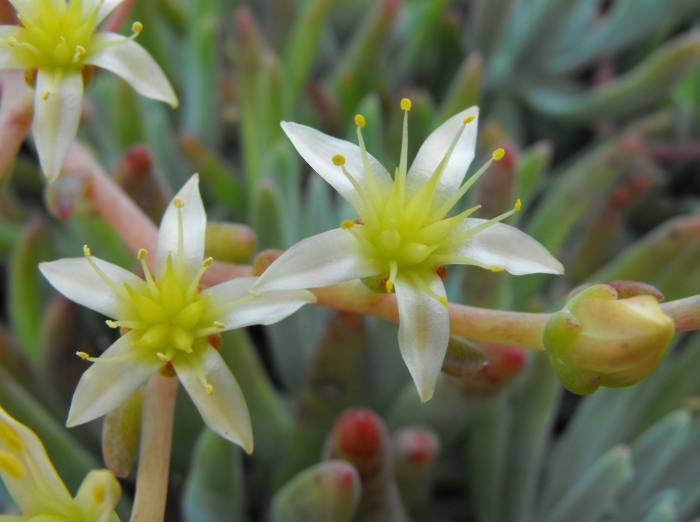Fingertips
(Dudleya edulis)
Fingertips (Dudleya edulis)
/
/

Stickpen
Public domain
Image By:
Stickpen
Recorded By:
Copyright:
Public domain
Copyright Notice:
Photo by: Stickpen | License Type: Public domain | License URL: https://creativecommons.org/public-domain/ | Uploader: Stickpen | Publisher: Wikimedia Commons | Title: Dudleyaedulis.jpg | Notes: {{BotMoveToCommons|en.wikipedia|year={{subst:CURRENTYEAR}}|month={{subst:CURRENTMONTHNAME}}|day={{subst:CURRENTDAY}}}} {{Information |Description={{en|A picture of [[:en:Dypsis decaryi|Dypsis decaryi]], a palm tree native to Madagascar.}} |Source=Transfer |





















































Estimated Native Range
Summary
Dudleya edulis, commonly known as Fingertips, is an evergreen succulent native to the chaparral and coastal sage scrub of Southern California and Baja California, Mexico. It typically forms rosettes of fleshy, finger-like leaves, which contribute to its common name. The plant reaches a modest size, usually not exceeding 12 inches in height or width. Dudleya edulis produces flowers with pointed white to cream petals about a centimeter long, which rise above the foliage on slender stalks during the bloom period from May to July. The flowers are modest in size but can add a delicate touch to the succulent’s sculptural form.
Fingertips is valued for its low water requirements and its ability to thrive in rocky, well-drained soils, making it an excellent choice for drought-tolerant landscapes, rock gardens, and container plantings. It is also appreciated for its year-round foliage interest and its role in supporting native pollinators. When grown in cultivation, it prefers full sun to part shade and requires very little water once established, reflecting its adaptation to arid environments. While generally low-maintenance, Dudleya edulis can be susceptible to root rot if overwatered or planted in poorly draining soils. It is also prone to mealybugs and aphids, which can be managed with careful monitoring and appropriate treatments.CC BY-SA 4.0
Fingertips is valued for its low water requirements and its ability to thrive in rocky, well-drained soils, making it an excellent choice for drought-tolerant landscapes, rock gardens, and container plantings. It is also appreciated for its year-round foliage interest and its role in supporting native pollinators. When grown in cultivation, it prefers full sun to part shade and requires very little water once established, reflecting its adaptation to arid environments. While generally low-maintenance, Dudleya edulis can be susceptible to root rot if overwatered or planted in poorly draining soils. It is also prone to mealybugs and aphids, which can be managed with careful monitoring and appropriate treatments.CC BY-SA 4.0
Plant Description
- Plant Type: Succulent
- Height: 0.2-0.6 feet
- Width: 0.8-1.5 feet
- Growth Rate: Slow
- Flower Color: White
- Flowering Season: Spring, Summer
- Leaf Retention: Evergreen
Growth Requirements
- Sun: Full Sun, Part Shade
- Water: Very Low, Low
- Drainage: Medium, Fast
Common Uses
Bee Garden, Bird Garden, Drought Tolerant, Edible*Disclaimer: Easyscape's listed plant edibility is for informational use. Always verify the safety and proper identification of any plant before consumption., Fire Resistant, Hummingbird Garden, Low Maintenance, Potted Plant, Rock Garden
Natural Habitat
Chaparral and coastal sage scrub of Southern California and Baja California, Mexico
Other Names
Common Names: Lady Fingers, Mission Lettuce, The San Diego Dudleya
Scientific Names: , Dudleya edulis, Cotyledon edulis, Stylophyllum edule, Echeveria edulis, Sedum edule,
GBIF Accepted Name: Dudleya edulis (Nutt.) Moran